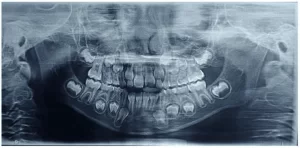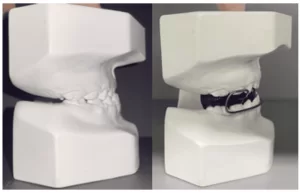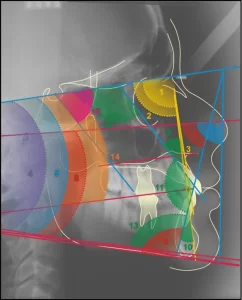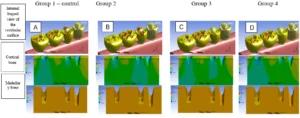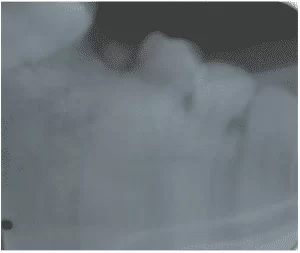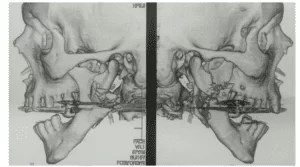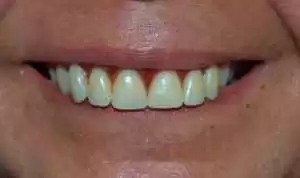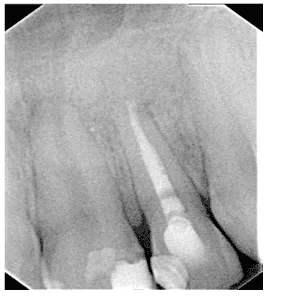CASE REPORT
CAMPOS, Gabrielly Caldeira [1], COSTA, Maria Beatriz Tavares da [2], PESSOA, Juliana Victória de Sousa [3], ARAÚJO, Marhia Eduarda Vilela de [4], ARAUJO, Priscila Pinto Brandão de [5], MEDINA, Pollyanna Oliveira [6]
CAMPOS, Gabrielly Caldeira. et al. The use of esthetic-functional space maintainer in pediatric dentistry: a case report. Revista Científica Multidisciplinar Núcleo do Conhecimento. Year 08, Issue 08, Vol. 02, pp. 36-54. August 2023. ISSN: 2448-0959, Access link: https://www.nucleodoconhecimento.com.br/dentistry/use-of-esthetic-functional, DOI: 10.32749/nucleodoconhecimento.com.br/dentistry/use-of-esthetic-functional
ABSTRACT
The use of space maintainers in deciduous and mixed dentition is of significant importance as it helps prevent the development of malocclusions, including those resulting from early tooth loss, by preserving the necessary space for the eruption of permanent teeth. This study aims to report a clinical case of a 10-year-old female patient. The patient presented at the Pediatric Dental Clinic of the School of Dentistry at UFAM with the main complaint of dissatisfaction with her smile. During the anamnesis, the mother reported trauma to elements 51 and 61, and the clinical examination revealed prolonged retention of these elements and malocclusion. After the extraction of the retained elements due to delayed eruption of permanent teeth, the fabrication of a space maintainer appliance was indicated for esthetic and preventive purposes. A Hawley Plate was used for this purpose, and an acrylic tooth was added for esthetic purposes. After a 5-month period of appliance use, the central and lateral incisors erupted naturally in the mouth. This treatment approach resulted in the maintenance of the upper arch perimeter, providing the necessary space for permanent teeth to erupt, thereby preventing dental inclinations and space loss, avoiding the onset of deleterious oral and parafunctional habits, future complex malocclusions, and ensuring the patient’s aesthetic well-being.
Keywords: Impaction, Oral rehabilitation, Space Maintainer.
1. INTRODUCTION
Deciduous teeth are considered notable and important natural space maintainers, helping to prevent disorders and complications such as the reduction of the perimeter of the upper or lower arch, dental migrations, lack of space, among other conditions that promote instability and asymmetry in occlusion (ALMEIDA et al., 1999; ALENCAR; CAVALCANTI; BEZERRA, 2007). Deciduous teeth are in a state of prolonged retention when they persist in the mouth beyond the expected time for their exfoliation. Among the deciduous teeth, the last to exfoliate is the upper canine at around 11 years old, and the lower second molar between 10 and 11 years of age. When deciduous teeth are in a state of prolonged retention or atypical resorption, they naturally create an obstacle to the eruption of the permanent tooth, potentially affecting its position in the dental arch (CORTELETI et al., 2016).
The prolonged retention of anterior deciduous teeth can result in ectopic eruption and/or impaction of the successor element, an unpleasant factor for the individual since it can affect the aesthetics of their smile, compromise the child’s self-esteem, personality, leading to a lack of confidence, and a lack of psychological well-being. Orthodontics has been working on the prevention of malocclusions, including those resulting from the loss of space for the eruption of permanent teeth (SILVA, 2007).
Impacted teeth are dental elements with delayed eruption due to a physical barrier that hinders the proper course of eruption. This anomaly has multifactorial causes and requires immediate intervention. Impaction, when it involves permanent teeth that have not yet erupted, can only be perceptible through radiographic examination (MACHADO et al., 2007).
In the case of impacted permanent dental elements, clinical follow-up of the patient is necessary due to the risk of migration of adjacent elements, causing a loss of space in the dental arch for the eruption of the successor element (GATTI; MAAHS; BERTHOLD, 2012).
The choice of the type of device should be based on biological and scientific principles, the needs of each patient, the individual’s age, as well as their ability to maintain oral hygiene and their level of cooperation during the treatment period (SILVA, STUANI, QUEIROZ, 2007).
Modesto (2010) classifies space maintainers as functional and esthetic-functional appliances. Removable and esthetic-functional devices are made of acrylic resin, and it is possible to add acrylic resin teeth during their fabrication, restoring aesthetics and function to the patient. The fixed device would be proposed in a clinical case where the patient is young and does not cooperate with the use of the appliance.
Given the above, this clinical case report will describe a pediatric patient with prolonged retention of deciduous teeth and delayed eruption of permanent teeth, emphasizing the importance of prescribing space maintainers after the extraction of retained deciduous teeth impacting the eruption of permanent teeth, demonstrating the significance of these devices in preventing potential occlusal and aesthetic problems.
2. CASE REPORT
A 10-year-old female patient, a native of Manaus, Amazonas, was referred to the Pediatric Clinic of the School of Dentistry at UFAM for orthodontic evaluation. During the anamnesis, the patient’s guardian described dissatisfaction with the smile as the main complaint, and she signed the Informed Consent Form (ICF).
Regarding information about the patient’s general health, the guardian informed that the child had asthma and managed the condition with prescribed medications (Clenil® HFA 200mg spray; Aeronil® spray; Sorine® SSC), following routine check-ups with a pediatrician. The mother also mentioned that the child tended to breathe through the mouth while sleeping and that at 4 years of age, during playtime, the child was hit by a shoe in the area of the anterior teeth. The guardian further mentioned that the child regularly consumed sucrose-containing foods and beverages between meals, approximately three to four times a week.
The intraoral examination revealed multiple whitish papules on the lower lip, a whitish line in the molar region on the right side suggestive of linea alba, presence of lingual coating, and melanotic pigmentation on the gums in the region of upper and lower incisors.
On extraoral examination, an increased lower third of the face and lip sealing at rest were observed. The patient had a straight facial profile (Figure 1), with an Angle class III molar relationship (mesio-vestibular cusp of the upper first molar located behind the mesio-vestibular groove of the lower first molar) and a protruded mandible.
Figure 1: Patient’s profile
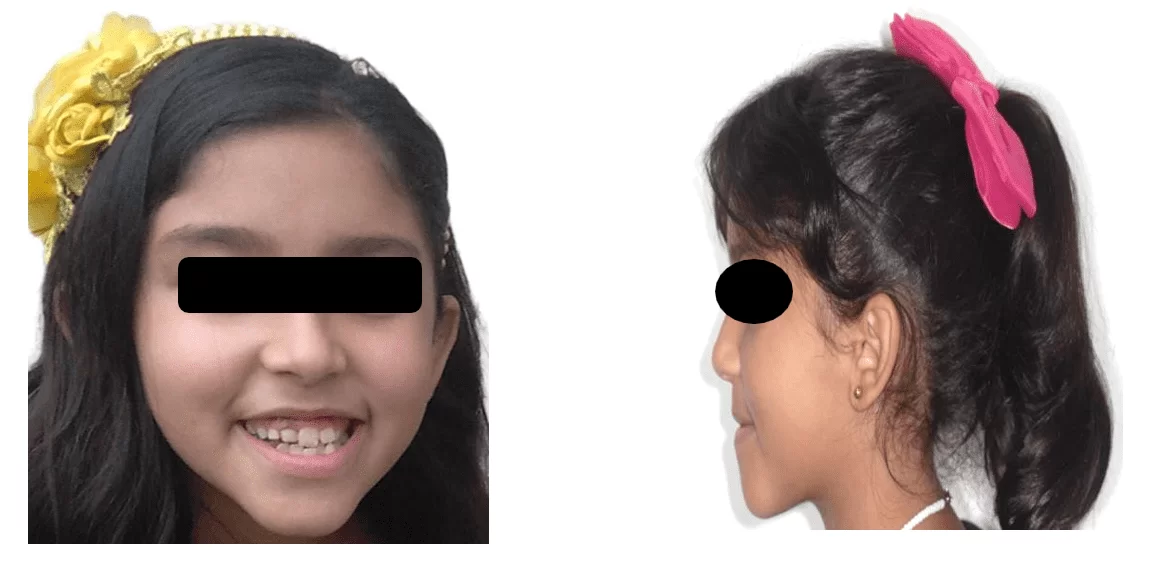
The intraoral examination and panoramic X-ray revealed upper and lower arches with dentition in the mixed dentition phase. A radiolucent image suggestive of carious lesions was noted in teeth 54, 55, 64, 65, 36, and 46. Prolonged retention of the upper right central and lateral incisors (51 and 52), crowding of teeth 31, 32, 41, 42, and apparent impaction of teeth 11 and 12 were observed, classified as Nolla stage 9 (Figures 2 and 3).
Figure 2: Periapical radiograph of deciduous and permanent incisors
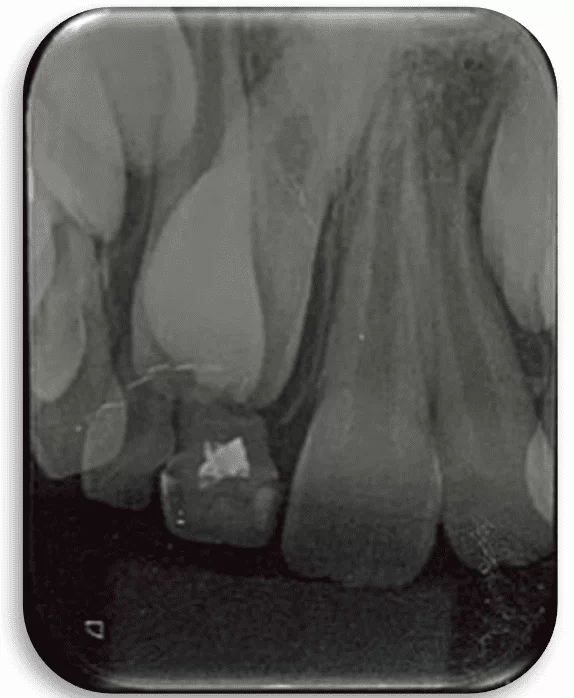
Figure 3: Panoramic radiograph
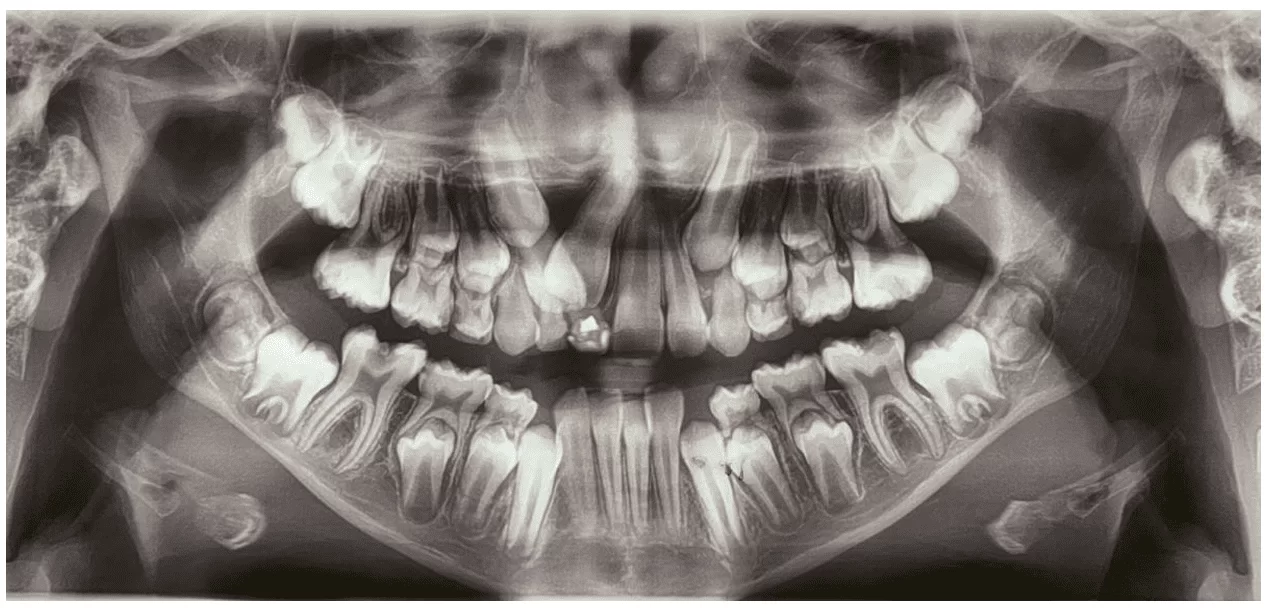
The panoramic radiograph also revealed maxillary sinuses with normal and well-aerated anatomical contours, septum without significant deviation, intact condyles, coronoid processes, and articular eminences with normal radiopacity, contours of the orbital floors without significant changes, as well as other anatomical structures within radiographic patterns of normality.
Based on the anamnesis, radiographic examinations, and intraoral and extraoral examinations, a treatment plan was established for the patient. The plan included restorative procedures on teeth 36, 55, and 65, extractions of teeth 51, 52, 54, and 64, functional esthetic space maintainer for the anterior-superior and posterior regions, and a Lip Bumper appliance for the treatment of Class III malocclusion and dental crowding.
The following procedures were performed: prophylaxis for biofilm control, Class II restoration with composite resin on teeth 36, 55, and 65, and extractions of teeth 51, 52, 54, and 64.
The extractions of teeth 51 and 52 were planned in an attempt to stimulate the eruption of teeth 11 and 12, and the extractions of teeth 54 and 64 were necessary due to extensive carious lesions and mobility observed clinically. All procedures were carried out in the outpatient clinic of the Pediatric Dentistry Department at the School of Dentistry.
The upper arch impression was taken using alginate (Hydrogum®), and the study model was poured in stone-type plaster (Asfer®) (Figure 3).
Figure 4: Study model
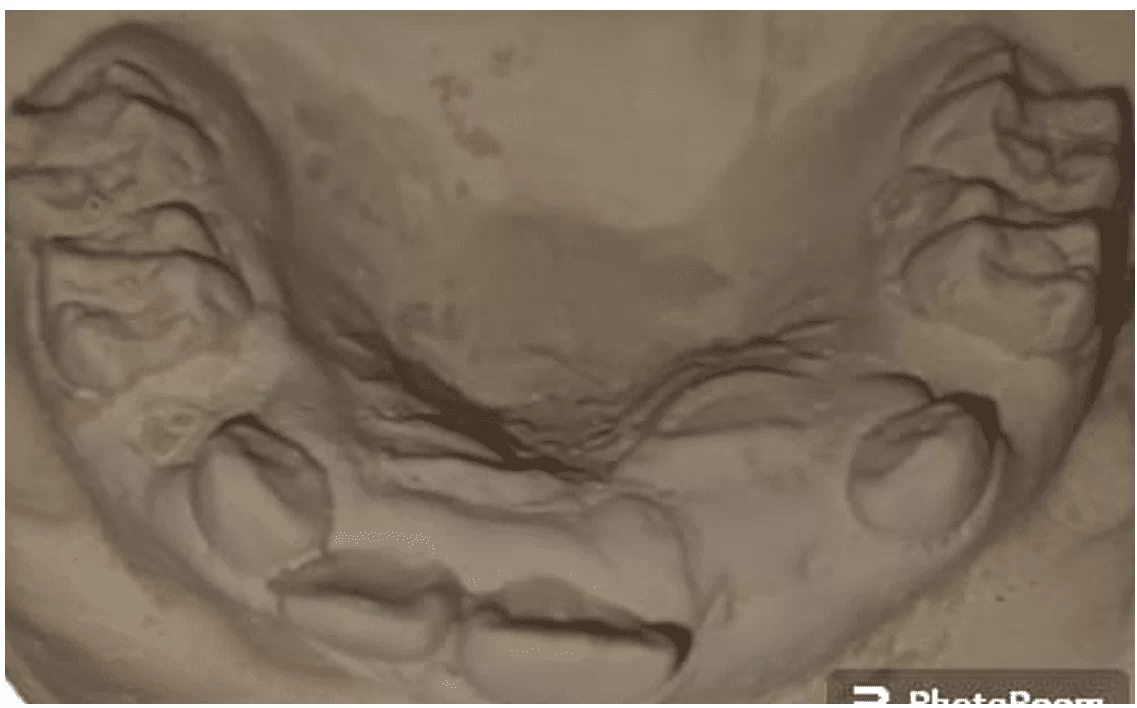
The study model was sent to the dental prosthetics laboratory for the construction of the device, requesting the addition of acrylic dental elements to enhance its aesthetics (Figure 4). Due to the lack of space to accommodate two permanent stock teeth, only tooth 21 was chosen for insertion.
The fabrication of the esthetic-functional space maintainer (Hawley plate) was installed in the upper arch with the objective of maintaining space, esthetic and functional rehabilitation, and prevention of parafunctional habits before eruption.
Figure 5: Removable esthetic-functional space maintainer
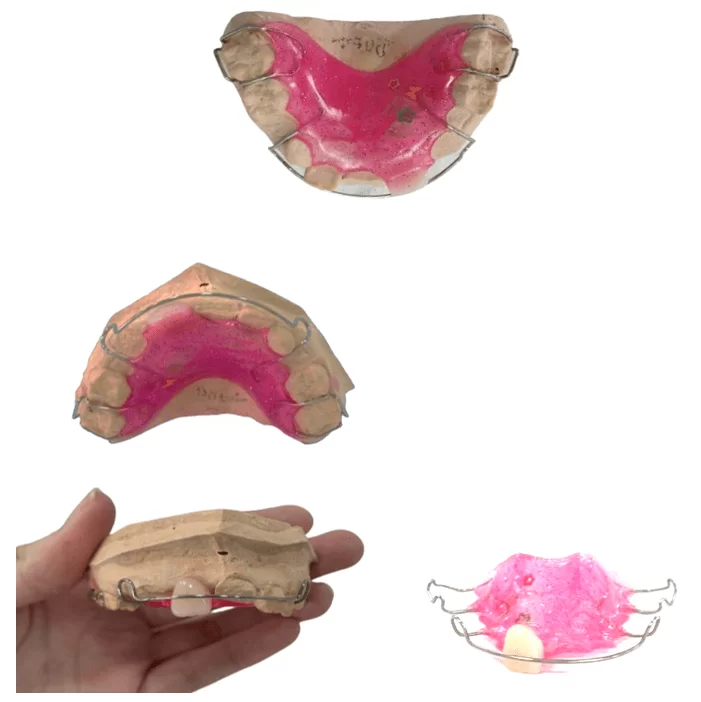
After the appliance installation, minor adjustments were made using orthodontic pliers (short 139) (Figure 5). The patient and her guardian were given guidance regarding the necessary care for the device, emphasizing the importance of maintaining oral hygiene.
Figure 6: Installation of the Esthetic-Functional Space Maintainer
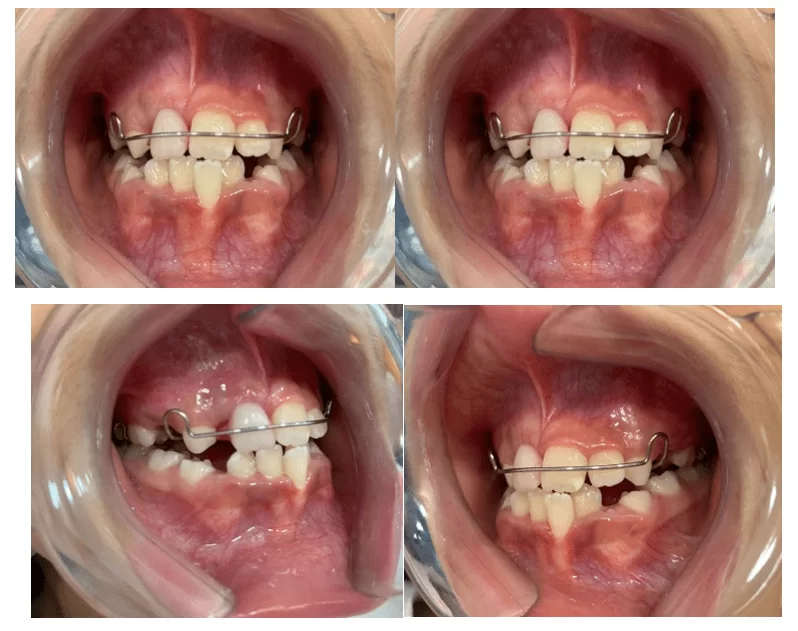
After two weeks of appliance use, the patient returned without any complaints regarding adaptation and expressed complete satisfaction with the aesthetic results obtained (Figure 6). Monthly follow-ups were scheduled to assess oral hygiene, adaptation to the device, and the eruption process of the permanent teeth (12 and 11).
Figure 7: Frontal photo after 2 months of appliance use
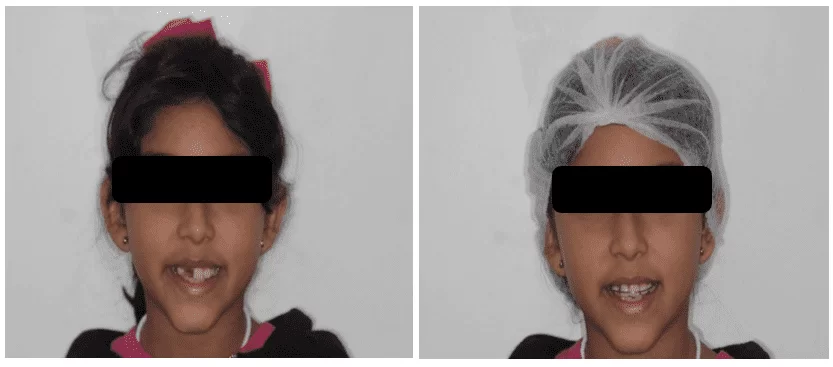
After two months of using the Hawley plate, no evidence of movement of the impacted teeth was observed during clinical and radiographic examination (Figure 7), so the child continued using the device. Eruptive movement signs were observed after 4 months of using the space maintainer (Figure 8), and for this reason, the appliance was removed.
Figure 8: Frontal photo after 2 months of appliance use
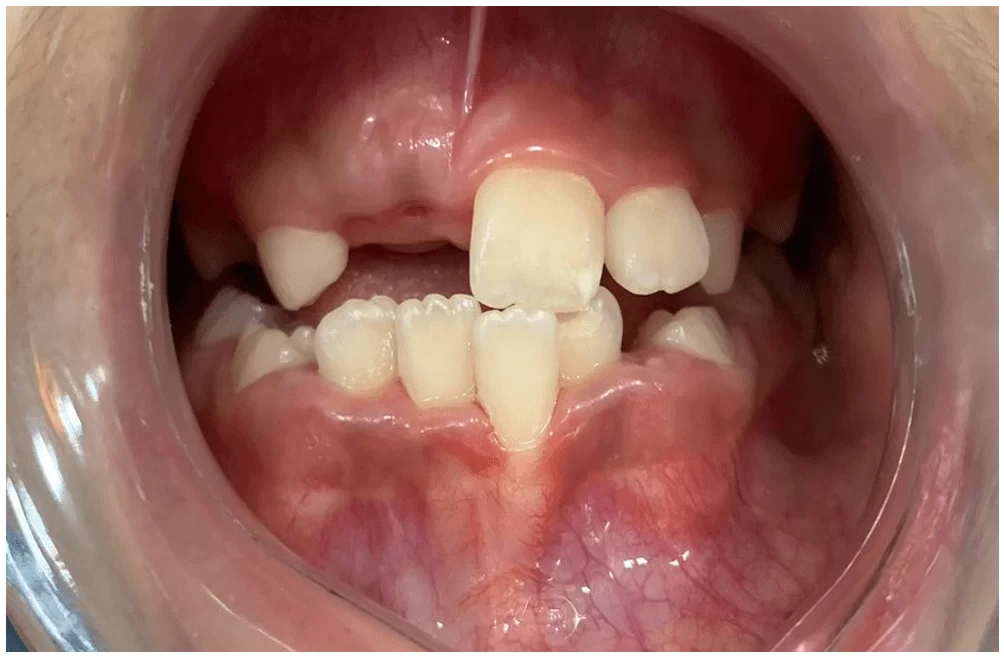
Figure 9: Periapical radiograph after 2 months of appliance use
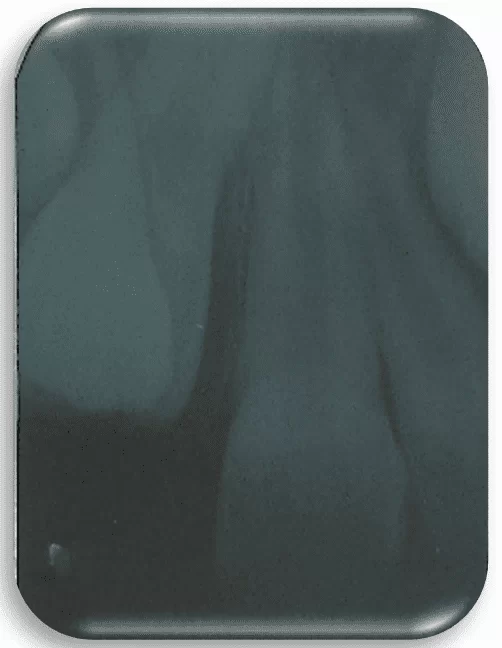
Figure 10: Photo after 4 months of appliance use
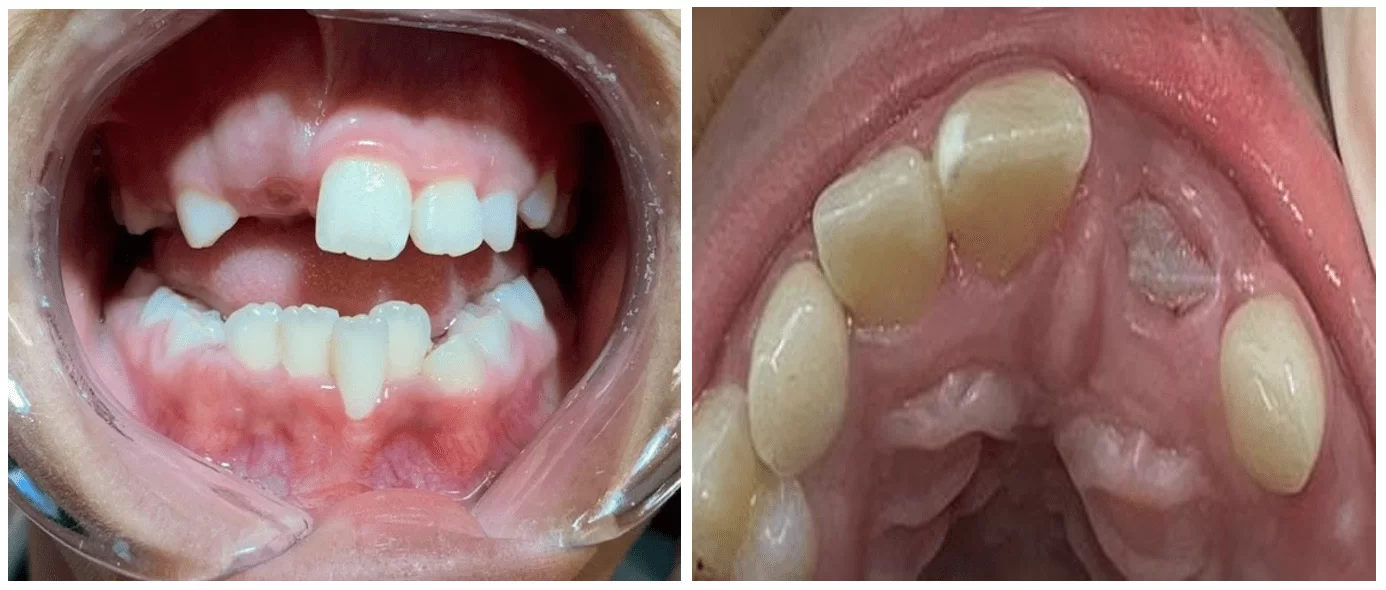
Figure 11: Periapical radiograph after 4 months of appliance use
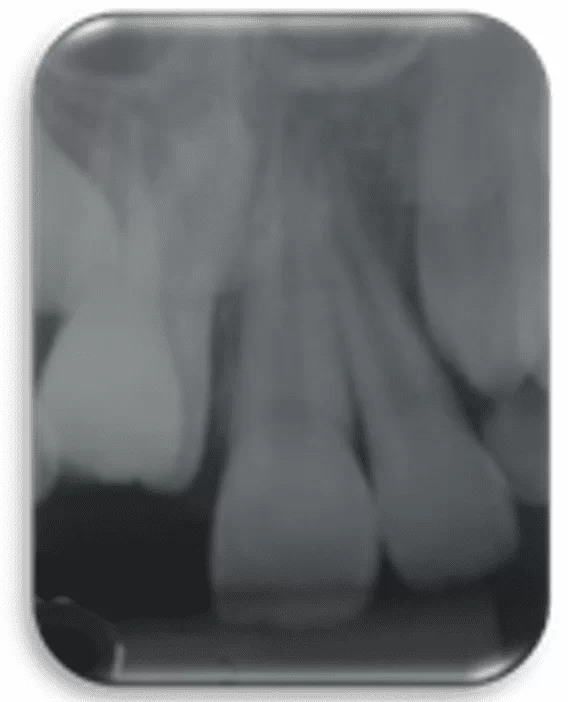
The patient is undergoing treatment at the dental clinic of the School of Dentistry at the Federal University of Amazonas. Due to personal issues, the patient did not attend the scheduled follow-ups, which prevented the installation of the Lip Bumper appliance in the lower arch and the continuation of the treatment. Orthodontic treatment needs to be adjusted according to the patient’s growth and cooperation. Therefore, for this presented clinical case, a new treatment plan will be developed.
3. DISCUSSION
The preservation of deciduous teeth and the maintenance of their anatomical dimensions through orthodontic means are crucial so that permanent teeth can erupt in their proper positions, thus preventing aesthetic and functional problems.
Prolonged retention and abnormal resorption of deciduous teeth create a mechanical barrier, making it difficult for the successor tooth to erupt or deviating it to an abnormal position in the dental arch (CANDEIRO et al., 2009). In the clinical findings of this case, deciduous teeth 51 and 52 showed prolonged retention, hindering the eruption of permanent teeth.
Impaction of permanent teeth can lead to complications such as ankylosis and root resorptions; therefore, early diagnosis is crucial. Dental impactions may occur during the transition from mixed to permanent dentition, a problem often encountered in orthodontic practice (MARTINS et al., 2004; SILVA et al., 2020). The patient in this clinical case presented a mixed dentition phase and impaction of permanent teeth 11, 12, and 13, with a loss of space for the eruption of these elements.
According to Ries Centeno (1955), the etiology of impacted teeth is related to tooth retention, where during the eruptive process, the tooth encounters a barrier preventing its natural progression. In this clinical case, the roots of the impacted permanent teeth were already at Nolla stage 9, while deciduous teeth 51 and 52 remained retained without mobility. Based on the anamnesis, the prolonged retention of deciduous elements was associated with the trauma the child suffered in this region at 4 years of age. Given the anatomical position of the deciduous elements in relation to the permanent ones, trauma to deciduous teeth may likely disrupt the progress of the germs of successor teeth (SENNHENN-KIRCHNER & JACOBS, 2006; TORRIANI, 2006).
In this case, the retained deciduous teeth were surgically removed in accordance with Nogueira (2023). In cases where deciduous teeth show prolonged retention, surgical removal of the deciduous element is recommended, followed by the installation of a space maintainer and monitoring the eruption process of the permanent tooth. In line with Fujita et al. (2014), the surgical removal of the deciduous tooth is performed after a careful evaluation of clinical and radiographic examinations, aiming to stimulate the eruption of the permanent teeth and prevent severe malocclusion.
Graber (1972), Moyers (1991), Correa et al. (1996), Almeida et al. (1999), Silva (1999) argue that there is no space loss in cases of early loss of teeth in the anterior upper arch, and there is no indication for the use of a maintainer. However, a systematic review by Menegaz et al. (2015) emphasizes the importance of placing a functional space maintainer, with the optional addition of an acrylic tooth to avoid parafunctional habits, enhance smile aesthetics, and offer psychosocial benefits to the child. In this clinical case, we opted for the Hawley plate as a space maintainer, with an acrylic tooth to prevent the development of parafunctional habits and promote aesthetics.
The removable space maintainer is easy to make, has excellent cost-effectiveness, and is easy to construct and adjust in the office (SANTOS; FONSECA; GUEDES-PINTO, 1997), as demonstrated in this case report, showing easy handling and maintenance. However, the patient’s age is an important factor in deciding to recommend this device, as it is contraindicated for children under 3 years of age due to lack of cooperation and their inability to tolerate the removable appliance (PIASSI; VOLSCHAN; LOUVAIN, 2000).
After early loss, space maintainer devices can be installed to guide the teeth into their correct positions and preserve the space for the successor tooth to erupt in the proper position (SOUZA, 2003). In agreement with Guimarães and Oliveira (2017), space maintainers enable the maintenance of an appropriate perimeter for the eruption of permanent teeth. Additionally, they play a preventive role by preventing the onset of occlusal problems, resulting in numerous advantages. This was demonstrated by the good use of the maintainer by the patient in this clinical case, where no parafunctional habits were developed, and the child’s psychological well-being was maintained. On the day of installation, it was her birthday, and the mother reported that the child uses it daily for all her activities with great joy.
Pereira et al. (2010) stated that the main mishaps and causes of failures of these space maintainers reported in this clinical case are: poor oral hygiene, loss of the appliance, adjustments of the clasps over the treatment time, and discomfort during the adaptation period. Therefore, it is necessary to adapt the oral environment and teach the patient how to perform proper brushing and cleaning of the appliance, while also educating the guardian to supervise the child’s hygiene (DESHPANDE; BENDGUDE; KOKKALO, 2018). The patient in the reported case, in addition to clinical interventions to adapt the environment, was advised along with her guardian to remove the appliance during meals and perform thorough brushing.
It is important to emphasize that patients using this type of device need to be monitored to address problems that may arise due to the child’s maxillary growth, requiring adjustments or even replacement of the appliance, as will be done in this clinical case. The appliance was discontinued due to the eruption of the permanent teeth, as it fulfilled its purpose, and new plans will be made (ISSÃO, 1994; ABUJAMRRA, FERREIRA, PINTO, 1994).
Preventive orthodontics is necessary to prevent the worsening of future occlusions (CRUZ et al., 2014). When orthodontic actions are performed in childhood, they become agents of prevention against the development of occlusal disharmonies and parafunctional habits that may arise during this stage of craniofacial development (ARAÚJO et al., 2023).
4. CONCLUSION
Early diagnosis and orthodontic intervention are crucial to prevent complex occlusal problems in the future.
The Hawley plate is an efficient option for aesthetic and functional rehabilitation of the anterior region, as well as preventing the development of parafunctional habits.
Patient follow-up is essential to assess potential needs for appliance replacement, repairs, wear and tear, eruption of permanent teeth, and evaluation of oral hygiene.
REFERENCES
ABUJAMRRA, C. M.; FERREIRA, S. L. M.; PINTO, A. C. G. Manifestaçöes sistêmicas e locais durante a erupçäo de dentes decíduos. Rev. bras. odontol, pp. 6-10, 1994.
ALENCAR, C. R. B.; CAVALCANTI, A. L.; BEZERRA, P. K. Me. Perda precoce de dentes decíduos: etiologia, epidemiologia e conseqüências ortodônticas. Ciências Biológicas e da Saúde, Ponta Grossa, v. 13, n. 1/2, pp. 29-37, mar./jun. 2007.
ALMEIDA, R.R. et al. Ortodontia preventiva e interceptora: mito ou realidade? Rev Dental Press Ortodon Ortop Facial, v.5, n.6, pp.87-108, nov./dez. 1999.
ARAÚJO, P. P. B. et al. Maloclusão uma questão de saúde pública. In: DENDASCK, Carla Viana; et al. Rev. Núcleo do Conhecimento, pp. 53-63, 2023. Disponível em: <https://www.nucleodoconhecimento.com.br/livros/ciencias-da-saude/maloclusao#_ftn1>. Acesso em: 10 jun. 2023.
CANDEIRO, G. T. M. et al. Ocorrência de Molares Supranumerários em Pacientes da Clínica de Radiologia da Universidade Federal do Ceará. Rev Fac Odontol, Porto Alegre. 50(2): pp.30-32, 2009.
CENTENO, Guillermo A. Ries. Cirurgia bucal, con patologia, clinica y terapéutica. El Ateneo, 1955.
CORREA, M. S. N. et al. Atualização na clínica odontológica: a prática da clínica geral. São Paulo; Artes médicas, v. 16, pp. 411–40, 1996.
CORTELETI, J. et al. Retenção prolongada de dente decíduo por impactação de dente supranumerário em criança de 12 anos. Revista da Associacao Paulista de Cirurgioes Dentistas, pp. 268–72, 2016.
CRUZ, A. C. O., et al. A Importância da ortodontia preventiva e interceptativa. Rev. Fundação universitária a vida cristã, Pindamonhangaba, 2014.
DESHPANDE SS, BENDGUDE VD, KOKKALO VV. Survival of bonded space maintainers: a systematic review. Int J Clin Pediatric Dent., pp. 440-445, 2018.
FUJITA H, et al. Prolonged retention of primary teeth and TMD from the archaeological sample in the Edo Japanese. Eur J Prev Med, v. 2, pp. 110–113, 2014.
GATTI, F. S.; MAAHS, Márcia, A. P.; BERTHOLD, T. B. Arco lingual como mantenedor de espaço na perda precoce de dentes decíduos. RFO UPF, v. 17, n. 1, pp. 91-95, 2012.
GUIMARÃES, C. A; OLIVEIRA, R. C. G. Perda precoce de dentes decíduos relato de caso clínico. Uningá Review, v. 29, n. 2, 2017.
GRABER, Thomas M. Orthodontics principles and practice. Growth and development, pp. 127-128, 1972.
ISSÃO, M. Primeiro molar permanente. Ortodontia: bases para a iniciação. 3.ed. São Paulo: Artes Médicas, cap.12, pp.233-242, 1994.
MACHADO, A. et al. Erupção espontânea de incisivos centrais superiores impactados após a abertura ortodôntica de espaço. Rev Clin Ortodon Dental Press, pp. 43–52, 2007.
MARTINS, P. P. et al. Avaliação radiográfica da localização de caninos superiores não irrompidos. Revista Dental Press de Ortodontia e Ortopedia Facial, v. 10, n. 4, pp. 106–114, 2004.
MENEGAZ, A. M. et al. Efetividade de mantedores de espaço em odontopediatria: revisão sistemática. Revista da Faculdade de Odontologia-UPF, v. 20, n. 2, 2015.
MODESTO, S. S. Mantenedores de espaço. 2010. Monografia (Habilitação Profissional Técnica de Prótese Dentária) – Etec “Philadelfo Gouvêa Netto”, São José do Rio Preto, 2010.
MOYERS, R. E. Tratamento precoce. MOYERS, RE Ortodontia, pp. 292–368, 1991.
NOGUEIRA, J. S. E. Retenção prolongada de dente decíduo: relato de caso. Brazilian Journal of Implantology and Health Sciences. Vol. 5, Issue2 , pp.110-120, 2023.
PIASSI, E.; VOLSCHAN, B.; LOUVAIN, M. C. Mantenedor de espaço fixo para região anterior na dentição decídua. J Bras Odontopediatr Odontol Bebê, v. 3, n. 14, 2000.
SANTOS, N. P.; FONSECA, Y.; GUEDES-PINTO, A. C. Reabilitação bucal em odontopediatria. Odontopediatria, São Paulo, pp. 685–719, 1997.
SENNHENN‐KIRCHNER, S.; JACOBS, H‐G. Traumatic injuries to the primary dentition and effects on the permanent successors–a clinical follow‐up study. Dental Traumatology, v. 22, n. 5, pp. 237-241, 2006.
SILVA, P. R. B. Mantenedores de espaço. Monografia. Faculdade de Odontologia, Universidade de São Paulo, Bauru, 1999.
SILVA, F. W. G. P.; STUANI, A. S.; QUEIROZ, A. M. Importância da manutenção de espaço em odontopediatria. Clín.-Científ., v. 6, n. 4, pp. 289-292, 2007.
SILVA, K. D. et al. Tracionamento de caninos inclusos: revisão de literatura. Revista de odontologia da UNICID, v. 31, n. 3, p. 71, 2020.
SOUZA, C. O. Consequências e tipos de tratamentos após perda precoce de dentes decíduos. [monografia]. Piracicaba (SP): Universidade Estadual de Campinas-Faculdade de Odontologia, 2003.
TORRIANI, Dione Dias et al. Histological evaluation of dog permanent teeth after traumatic intrusion of their primary predecessors. Dental Traumatology, v. 22, n. 4, pp. 198-204, 2006.
[1] Undergraduate student in Dentistry. ORCID: 0009-0001-8398-2390. Currículo Lattes: http://lattes.cnpq.br/7301946389987967.
[2] Undergraduate student in Dentistry. ORCID: 0009-0003-0477-2614. Currículo Lattes: http://lattes.cnpq.br/1977203311524825.
[3] Undergraduate student in Dentistry. ORCID: 0009-0003-8461-6338. Currículo Lattes: http://lattes.cnpq.br/1832010931426679.
[4] Undergraduate student in Dentistry. ORCID: 0009-0001-1734-8455. Currículo Lattes: http://lattes.cnpq.br/8709140095376311.
[5] Continuing education in Pediatric Dentistry, Certification in Laser Therapy, Specialization in Orthodontics and Functional Jaw Orthopedics, Specialization in Public Health and Orthodontics, Master’s in Orthodontics, Ph.D. in Orthodontics. ORCID: 0000-0002-5514-0911. Currículo Lattes: http://lattes.cnpq.br/1678395879499706.
[6] Co-advisor. Ph.D. in Dental Sciences, Concentration Area: Pediatric Dentistry. ORCID: https://orcid.org/0000-0003-1939-1294. Currículo Lattes: http://lattes.cnpq.br/3069281295045820.
Submitted: July 28, 2023.
Approved: August 8, 2023.

